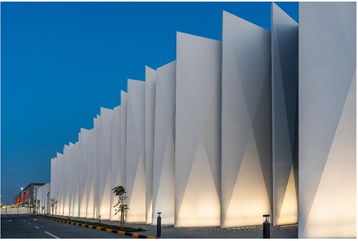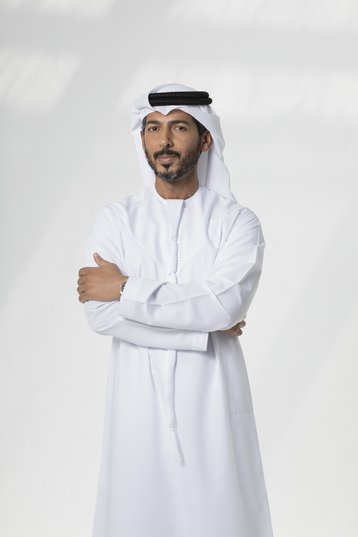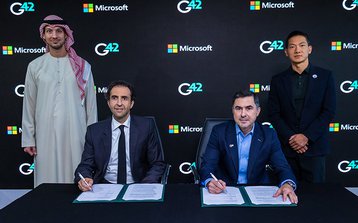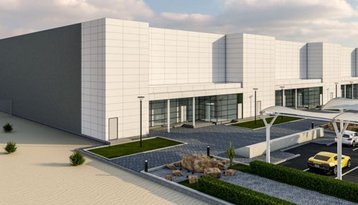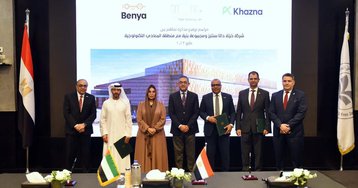Dubai-based Khazna is the leading provider of wholesale colocation in the United Arab Emirates, putting up buildings for cloud providers and large enterprises. It is growing fast, with 16 data centers between Abu Dhabi and Dubai, and has a strong link to AI, through its owner.
When we spoke to the CEO, Hassan Alnaqbi, Khazna had recently opened two facilities, with another due to open before this article was published.
Khazna is not much more than a decade old, and started out as a state-directed initiative. It was founded in 2012 by Mubadala Investment Company, a state-owned holding company or National Wealth Fund, which also owned AMD’s chip-making spinoff GlobalFoundries, until it went public via an IPO in 2021.
“The reason Mubadala invested in this particular sector of the business was the lack of any infrastructure availability within the UAE and the entire region,” explains Alnaqbi. “The focus from Mubadala back then was to actually create an infrastructure that can support the country into the digital transformation, and also provide a robust solution for specific and niche markets.”
Alnaqbi was with Khazna more or less from the start, coming across from du, one of the UAE’s two main telcos (formerly the Emirates Integrated Telecommunications Company) for the period from 2012 to 2014 when the business was being put together.
The Khazna history
“I started the operation of the company,” he says. “I launched the business and launched the operation. We had two sites: Abu Dhabi 1 (AUH1) in Masdar City, and Dubai 1 (DXB1) in Maydan. “I remember very well that the growth was very, very slow,”
Back then, there was no hyperscale model to speak of, and Mubadala wanted to set up a data center company to support the government and telcos. The company started with 13 customers made up of government entities and telco operators.
The government business was active because the public sector was “very aggressive in the acceleration of their smart government solution, digital transformation, and sectors like cybersecurity,” Alnaqbi says.
And that steered Khazna towards a wholesale model. “Our focus was mainly to tackle the requirements of the government, which has critical data it wants to store, and not necessarily to go into the colo mode,” he explains. “So Khazna is a wholesale operator that offers the flexibility of enterprises and government owning their own space securely, within their own remit and not having a shared space, like other colo providers.”
Colo was a difficult sale back then, but the telcos were a gateway: “A lot of enterprises had not really adopted any cloud solutions, and were very protective in terms of securing their IT environment,” Alnaqbi says. “The telco operators were engaging with small to medium businesses, and large enterprises on the retail side, so they built an ecosystem within Khazna to go and offer shared or colo solutions to the enterprise market.”
That was phase one, but things have changed since then - first to the cloud, and then to AI.
“In 2017, we started seeing cloud players coming into the region,” Alnaqbi recalls. “The enterprise mindset has changed towards the scalability that the cloud provides and the reduced cost on them from the operational perspective.”
That was a “complete mindset shift”, he says: “We have shifted our design principles to specifically meet the demands of the cloud players. In 2019, we started landing some of the global players who are leading the cloud domain, on the enterprise side, on the ERP side, and also on the full stack of cloud services.”
Then in 2020, Mubadala and du (which had a minority share) sold Khazna to the Emirati AI technology conglomerate G42.
“G42 took over Khazna prudently, because they are one of the biggest users of data centers,” explains Alnaqbi. “That fits with their agenda of leading in AI development.”
G42’s AI developments include multiple large language models (LLMs), including the first Arabic LLM with more than 30 billion parameters, which is now being adopted by Microsoft Azure. It has also funded Cerebras, the developer of giant wafer-scale AI chips
The company’s involvement has changed Khazna’s focus from “designing specifically for the cloud layer, to looking at how we can embrace the AI infrastructure requirement within the data center space,” says Alnaqbi.
In 2021, Khazna expanded through a deal between G42 and the state-owned incumbent telco Etisalat (previously the Emirates Telecommunications Group), now branded as e&.
“Etisalat was our main competition in the UAE, in terms of providing data center solutions, but a lot of telco operators, globally, divested data centers from their portfolio because it's not a core business to them. And that's exactly what happened here,” says Alnaqbi.
“We created a joint-venture partnership. G42 is the majority with 60 percent and e& is the minority with 40 percent equity,” he says. “We consolidated all their data center space under Khazna and, with that, we became the largest data center operator not only in the UAE but in the entire MENA (Middle East and North Africa) region from a capacity perspective.”
That’s a big deal: “What we have today is basically more than 300MW that is contracted in terms of capacity contracts,” Alnaqbi says. “We have about 175MW active and operational and handed over to the clients, the rest is being handed over as we speak within the next 18 months.”
Beyond that, there is fast organic growth: “We have secured about another 250MW which is basically expanding on what we have today within our own ecosystem. That's coming out within the next five years.”
And then, there’s the projected AI boom. “We have launched our first AI-ready data center, AUH6, which is the first of its kind within the region.”
Arabic AI
“G42 has taken a different approach to AI,” he says.”They realize that to take a lead in this ecosystem, you have to partner with global players. They have announced a partnership with Microsoft, and OpenAI. They are co-developing LLMs that can sit within the Azure platform and can be beneficial to OpenAI.”
G42’s approach is to focus on “the market we are in,” says Alnaqbi. “G42 realized that sitting within an Arabic country, and being part of the country's agenda of developing and taking a leading position on AI, that means focusing on the Arabic languages.”
The world has more than 300 million Arabic speakers, and that is a significant opportunity, he says: “There is a huge population that speaks Arabic that may actually require a certain development of LLMs that help certain sectors like banking, financial institutions, investment sectors, and oil and gas, where they can use the Arabic languages to have call centers completely digitalized and AI-driven, with automatic response and voice recognition.”
The challenge is that training AI systems needs source data, and there is less of this available in Arabic than in English. “I'm not an AI expert, but I understand it's all about the quality of data,” Alnaqbi says. “Apart from having data from the governments, they went to all the Arabic libraries, books, and encyclopedias in Arabic, and scanned books written in Arabic day-by-day and hour-by-hour.”
Processing and training on that data allowed G42 to create large datasets and build Jais, an Arabic LLM with over 30 billion parameters: “That's been recognized by Microsoft and I was in Abu Dhabi when Satya [Nadella, Microsoft CEO] mentioned that we are trying to incorporate the Jais model within the Azure Cloud,” says Alnaqbi.
At the same time, Khazna is building infrastructure tailored to the needs of G42 and LLMs like Jais, Alnaqbi says. “We understand that to build a data center for the cloud is a completely different ballgame, than building a data center for AI,” he explains.
Beyond the early training facilities, Khazna saw a need for inference, where AI is applied, the CEO says: “The AUH6 development was designed for AI infrastructure from the inference perspective. We're not going to be using this to train models.”
AUH6 will deliver a mix of cloud and inference, which Alnaqbi describes as “challenging.” The inference system must be able to access data instantly, he says, “but the density of the cabinet is [around 50-60kW], not as high as you need for training. For that, you can need up to 100-150kW per cabinet. That's where the challenge starts!”
And it’s a challenge Khazna will be taking on.
G42 has announced the Condor Galaxy cloud AI platform consisting of nine interconnected four exaFLOP AI supercomputers giving a total planned capacity of 36 exaFLOPs. It has delivered the first 54 million core node (CG-1), which includes 64 Cerebras CS-2 systems, and is working to build two more in the US, CG-2 and CG-3.
In the UAE, Alnaqbi reveals: “We are on the verge of finalizing the design to go into the market for building one of our biggest AI training clusters. That will come probably in the next 18 to 20 months. It will be a high-density design built to cater for training AI models and it's going to be one of our biggest clusters.”
Alnaqbi has no further details, and DCD has asked if the facility is going to be one of G42’s Condor Galaxy or a new design. Alnqbi says the facility has to have high densities. “The issue is how many servers you can put within one cabinet, so the model is trained from one server to another without having to cross 90 meters of distance.”
Given those constraints, he says the training facility will be “four or five times what we are doing today in one cluster.”
Balancing AI and cloud
Is there a danger that Khazna might shift too quickly to AI, and miss opportunities in cloud and enterprise? “You're absolutely right. I think this is why, within the management and leadership, we wanted to segregate the two tracks so then we don't get into the excitement of the AI track and then forget our own organic business,” Alnaqbi says.
The Khazna CEO says this gives a “clear focus on both sides,” explaining: “Business as usual for us is taking what we have into the next stage of growth. We focus on deploying cloud and hyperscale data centers for the top players, and we will continue working with them to deploy their cloud - because that's growth by itself. There is huge growth coming up, and we know the region needs a lot of [cloud].”
Meanwhile, “within the company, I'm trying basically to structure AI completely separate from the other businesses so it doesn't get into the excitement and people lose track on the other side.
“It's a challenging thing to do. But luckily, with the leadership, we created a completely different structure for the innovation and deployment of AI. That includes the design team, the project management team delivery, and so on. That's completely segregated.”
Within AI, he predicts that energy demands will push alternatives to Nvidia, shifting “from reliance on one particular vendor which has a huge pipeline to other providers.”
Obviously, Cerebras is one of those: “Cerebras has an AI infrastructure that allows you to train models faster. They might not yet have the right software. Like Nvidia, but they have a really super fast chip that allows a lot of the models to be trained faster.”
Commercializing new chips is a challenge, he says: “But I see now that a lot of parties are trying to find different solutions, like Qualcomm, AMD, and others.”
Sustainability
Energy demands lead us to talk of sustainability which is, he says, “The other element of AUH6 that we wanted. This is why we selected this location within Masdar City which has been renowned as one of the most sustainable developments not only within UAE but the entire region.”
The city is yet another state-funded initiative, being built by Masdar, another Mubadala subsidiary, with at least $22 billion of government money. It was announced in 2008 as “the world’s most sustainable eco-city” and was projected to be built in eight years.
While the project was endorsed by the Worldwide Fund for Nature (WWF) and the US Government, others have been skeptical. Professor Geoffrey Heal, of Columbia Business School has called it "a gimmick, a way of attracting publicity and attention."
Eight years on from the projected 2016 completion date, Masdar covers around one-sixth of the original area projected. It has about 10MW of solar power from the Masdar Solar Plant, along with some rooftop solar.
The city uses the grid for the rest of its needs and, as one would expect from a petro-state, that grid is heavily dependent (about 92 percent) on oil and gas, but the country is rapidly developing solar and nuclear power.
The new AUH6, one of several within Masdar, has its own solar plant, built by Emerge (a joint-venture between Masdar Energy and France’s EDF), which provides 7MW peak capacity AUH6 is projected to grow to around 32MW.
Building within Masdar means Khazana had to meet environmental standards, and AUH6 meets LEED gold, as well as Pearl 4 under the UAE’s own Estidama sustainable building rating system.
The climate in the UAE is not like the rest of the world, he says: “I visited Facebook's data center in Lulea in Sweden - and the challenge there was completely different,” Alnaqbi says. “They cannot pass the freezing air actually coming from outside into the data hall. They have to mix it with the hot air to bring the temperature up and then pass it on to the data center.
“In our case, we don't have the luxury of having cold air so we cannot design or facility with that mindset. We have the opposite issue, which is our hot climate. For most of the year, it is a very harsh and hot environment with lots of sandstone. You need to design your cooling solution to be reliant on what techniques and efficiency you can do within this harsh environment.”
With that in mind, AUH6 is designed to use less water: “We are using a new technology which is evaporative cooling, and that doesn't really require a lot of water,” Alnaqbi claims.
The technology is adiabatic cooling, which allows some cooling in the winter, and uses a water sprinkler to cool the air, a technique he notes is used in some Arabic houses.
There’s some liquid cooling in the racks he says, but not the direct-to-chip cooling used in training architectures, at least not provided by Khazna. “We allow the customer, if they want, to have chip-based cooling, but this will only allow them to go to 150kW in certain cabinets, not for the entire deployment.”
The diesel generators on the site use biofuel, he says. “Back in October last year, we announced we are shifting completely away from diesel to biofuel.”
Driven by government and clients
That decision is aligned with the government’s vision, he says, The UAE has promised that the country’s operations will achieve net zero by 2050, which is undermined by the nation’s plans to continue exploiting oil far beyond that date. Although this will be burnt by others, its total impact on the climate will be far from net-zero.
“The country has invested heavily in nuclear plant,” says Alnaqbi. “It may be the only country within the region that has a nuclear plant. We have four reactors that provide about 6GW of clean power, and we have also heavily invested in solar plant. Abu Dhabi and Dubai have invested in more than 10GW of solar plant over the next few years, which will contribute a lot to the grid.”
He concedes: “Yes, we are an oil-rich country, but I think we as a company, need to follow the direction of the country.”
The company’s clients also give it a mandate to focus on the sustainability of its infrastructure, he says: “For a lot of hyperscalers and other customers that we deal with, sustainability becomes one of the criteria for hosting their network,” Alnaqbi says.
Hyperscalers have global targets for sustainability, and the conditions in the UAE need explaining, he says. “We work as a partner and we openly discuss our roadmap and their roadmap to find where's the gap.”
Alnaqbi regularly meets with the big players’ chief sustainability officers “to look at what they're doing in different regions, how they are collaborating with other operators.” He says: “We take that seriously and set up sessions with workshops with them. I personally attend a lot of workshops with some of the hyper scalar leadership.”
Those sessions determine what is a practical sustainability target: “We come up with a common understanding. This region has its own challenges versus other regions, but they have criteria to follow and they need to tick a box.”
After this year, Alnaqbi might not have to go to so many of those workshops. The company doesn’t currently have its own sustainability officer, but this year there is a plan “to have a centralized function that will drive sustainability across all functions, not only from DCs, the design and engineering side but also across the entire company.”
Whoever fills this role, Alnaqbi is looking forward to introducing them to sustainability, UAE style: “It's going to be really funny to see how they will come to the realization about what they have to do within this environment,” he says. “It’s completely different here.”
Even without a central sustainability leader, Alnaqbi says Khazna’s sustainability efforts go beyond emissions: “We make sure our data centers are sustainable not just from the point of view of carbon emissions, but from the full ecosystem of sustainability, even to the point that we are probably the only operator in the region that has a zero waste policy.”
The zero-waste policy was announced in 2023, and certification is on the way, he says.
“Anything you get rid of within the data centers has to be split into materials, and goes to a factory that turns this waste into something - either power or usable material,” he says. “You need to make sure that it's zero waste to landfill.”
Beyond the UAE
Khazna is also expanding beyond its home territory: “We came to the realization that after we have penetration of data center availability in the UAE, the growth will be very minimal. So we started a few years back looking at markets that are underserved within the region and trying to enter those markets with our knowledge and expertise and the blueprint that we created.”
It’s a plan to be “the UAE champion,” he says, “and transform from being the largest local operator to the largest regional operator for data centers.”
Khazna has a project to build a 25MW facility which will be Egypt’s first hyperscale data center, working with local partner, Benya Group of Cairo.
What’s next? “We'd like to start doing something in countries like Saudi Arabia and Kuwait and Qatar and others. We're looking at different regions. Turkey is among those markets.”
The region has “huge opportunity for growth in the enterprise market, and a lot of potential for cloud adoption,” he says.
And once again government backing comes into play, and some of the business may emerge from ‘G2G’, or intergovernmental, deals. “The UAE has a very friendly relationship with the entire region, they guide us to look at a particular region, and that's something we're actually doing. The government is actually looking at technology with a different lens.”
UAE President, Mohammed bin Zayed Al Nahyan, who is also the ruler of Abu Dhabi, has set up an Executive Council for technology in general, which includes members of the board of Khazna, as well as of G42. “So you can see there's a lot of close collaboration - but also there is a vision that, the UAE is taking a leading position when it comes to AI, that will also require extensive investment in infrastructure, energy, data centers, and AI infrastructures, but also a lot of investment in human capital.”
When UAE ministers sign MOUs with other countries, he says, they have “data centers as one way of collaboration. Our name is always put there to explore collaboration with these governments to help them tackle the lack of data center infrastructure in their market. They present us as the expert in the domain.”
Part of that is driven by data sovereignty: “I think the entire region now has rules, but UAE and Bahrain, are actually ahead of the others. They have already created data sovereignty and data localization laws. That pushes the cloud players to deploy cloud presence within this region, not offer it from other regions.”
When players like Microsoft and Google create “sovereign cloud” products it is up to local providers to deliver facilities to support data residency, as well as security, he says: “We can ensure all the way to the CPU that your cloud is actually completely protected and completely encrypted within the public cloud, so a lot of work has been done on that domain.”
He says announcements from AWS and others show that sovereign cloud is emerging in Saudi and Qatar, for example, and other players like China’s Tencent (“basically the cloud of the East”) is also playing there.
“We've seen a lot of momentum going, and the entire region has invested heavily in connectivity, which is a key component for the success of cloud players within the region. Data centers are the foundation, but on top of that they need low latency.”
Above all, energy
Finally, he comes back to energy again, and the unknown demands of AI: “Nobody can tell you what the expectation for AI is,” Alnaqbi argues. “If you talk to people who are within that ecosystem, like G42, they expect about 500GW for the next 10 years of AI growth. And that's enormous.”
He continues: “I think power becomes the number one constraint for everything that we do in the future, What we have witnessed so far, doesn't equate to more than two percent of the capability of what AI can do. If you imagine increasing this to 20 percent, that will dramatically change.
And he warns: “Energy will be a key factor of success. We have seen recently that there is a scarcity of energy, with some countries and some cities tapping out from the power perspective. AI cannot evolve if there is no data center, and data centers cannot be developed if there is no energy.
“I think that's what we will see AI becoming constrained in some regions and some markets in the future.”
*This feature was first published in issue 52 of DCD Magazine.

